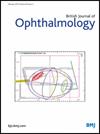Minimum set of outcome measures for non-advanced age-related macular degeneration: a Delphi consensus statement by the TRACER (intermediate age-related macular degeneration) study group
IF 3.5
2区 医学
Q1 OPHTHALMOLOGY
引用次数: 0
Abstract
Background The purpose of this study was to define a minimum set of outcome measures for patients affected by non-advanced age-related macular degeneration (AMD). Methods A structured Delphi consensus process was conducted by a panel of worldwide experts in treatment outcome registries, imaging, nutrition and other AMD aspects. The experts answered anonymously to a series of surveys, each followed by a face-to-face meeting to discuss the pooled results. Supporting literature was shared among the group members by a facilitator before each round. Finally, all the results were discussed and the consensus document was created based on the level of agreement between experts. Results Six rounds were conducted until a formal consensus was achieved. Five main sections were identified: demographic characteristics, health factors, functional, imaging and clinical outcomes. A minimum set of 28 outcome measures was subsequently developed and approved by all members. Based on the priority of various items, 24 fields were designated as mandatory, while the remaining were deemed optional. Five items are required only at baseline, 12 are to be assessed annually for changes and the remaining 0 1must be collected at each clinical assessment. Conclusion This newly defined minimum set of outcome measures for non-advanced AMD could be employed in future real-world data collection registries aimed at gathering comprehensive and longitudinally extensive clinical data on a global scale. This may help to elucidate the natural progression of non-advanced AMD and its response to new therapies. Data are available upon reasonable request. The data that support the findings of this study are available from the corresponding author upon reasonable request.非晚期年龄相关性黄斑变性的最小结果测量集:TRACER(中度年龄相关性黄斑变性)研究组的德尔菲共识声明
本研究的目的是为非晚期年龄相关性黄斑变性(AMD)患者定义一套最小的结局指标。方法由全球专家小组在治疗结果登记、影像学、营养和其他AMD方面进行结构化德尔菲共识过程。专家们匿名回答了一系列调查,每个调查之后都有一个面对面的会议来讨论汇总的结果。支持文献在每一轮之前由主持人在小组成员之间共享。最后,对所有结果进行讨论,并根据专家之间的一致程度创建共识文件。结果共进行了6轮讨论,最终达成正式共识。确定了五个主要部分:人口特征、健康因素、功能、影像学和临床结果。随后制定了至少28项成果措施,并得到所有成员的批准。根据不同项目的优先级,24个项目被指定为必选项目,其余项目被视为可选项目。5项仅在基线时需要,12项每年评估变化,其余10项必须在每次临床评估时收集。结论:新定义的非晚期AMD最小结果指标集可用于未来的真实世界数据收集注册,旨在收集全球范围内全面和纵向广泛的临床数据。这可能有助于阐明非晚期AMD的自然进展及其对新疗法的反应。如有合理要求,可提供资料。支持本研究结果的数据可根据通讯作者的合理要求提供。
本文章由计算机程序翻译,如有差异,请以英文原文为准。
求助全文
约1分钟内获得全文
求助全文
来源期刊
CiteScore
10.30
自引率
2.40%
发文量
213
审稿时长
3-6 weeks
期刊介绍:
The British Journal of Ophthalmology (BJO) is an international peer-reviewed journal for ophthalmologists and visual science specialists. BJO publishes clinical investigations, clinical observations, and clinically relevant laboratory investigations related to ophthalmology. It also provides major reviews and also publishes manuscripts covering regional issues in a global context.

 求助内容:
求助内容: 应助结果提醒方式:
应助结果提醒方式:


